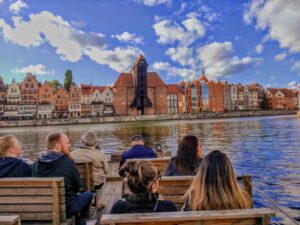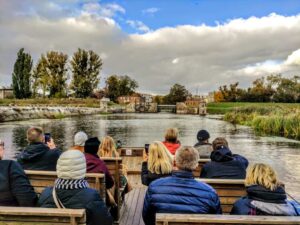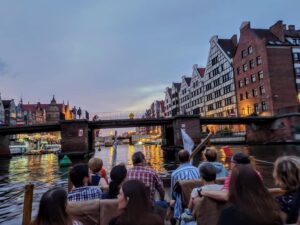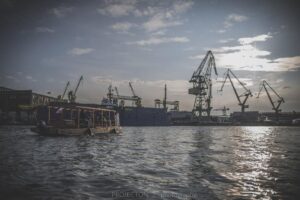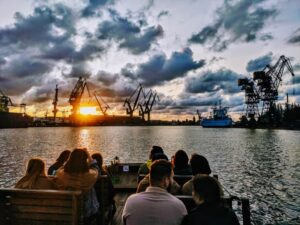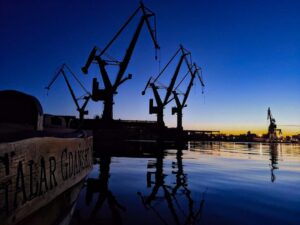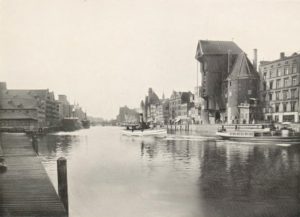 There are few countries in the world similar to Poland that can boast such a rich stock of unique customs. Although it would seem that they are of value only to Poles, in fact some of Poland’s cultural boons have been recognized internationally. We are talking primarily about timber rafting, a centuries-old tradition that has been included on UNESCO’s Intangible Cultural Heritage Lists. What is really behind the term “timber rafting,” what did the rafters do, and can we still meet them? Enjoy reading!
There are few countries in the world similar to Poland that can boast such a rich stock of unique customs. Although it would seem that they are of value only to Poles, in fact some of Poland’s cultural boons have been recognized internationally. We are talking primarily about timber rafting, a centuries-old tradition that has been included on UNESCO’s Intangible Cultural Heritage Lists. What is really behind the term “timber rafting,” what did the rafters do, and can we still meet them? Enjoy reading!
Timber rafting | What is that?
At the sound of such buzzwords as raftsman or timber rafting, some people – especially representatives of the younger generation – freeze in stillness. Although the above terms were once heard on a daily basis, and people working in this profession were the backbone of the transportation industry, today hardly anyone remembers them. Unfortunately, the realities of current times are gradually pushing us away from long-standing traditions, and fewer and fewer people want to nurture them.
So it is worth starting with the basics: rafting – what does it mean? In the past, rafting was defined as the transportation of various types of goods on rivers, but today the term is closely related to tourism. This is because nowadays tourists – as a tourist attraction – are transported on raft boats (mainly replicas). The capital of the rafting tradition is considered to be Ulanow – a town in Podkarpackie Province, located at the mouth of the Tan River to the San River. Not only were new rafts built here, but also young rafters were trained, who later engaged in river rafting on the Narew, Bug, San, Wieprz and, of course, the Vistula River.
Who were the rafters?
As the name suggests, rafters – also known as raftsmen, oryls – were people engaged in floating goods by river on a raft. As a rule, this profession was occupied by peasants – during the spring and summer seasons they sold their manufactured goods in larger cities, often hundreds of kilometers away from their place of residence. Although at first not many people worked as oryls, over time the aforementioned professional group began to increase, until it eventually grew to an impressive size. For this reason, in the 17th century an organization resembling a city guild was created, whose members – raftsmen – were covered by numerous rights. This was mainly thanks to Wladyslaw IV Vasa, who granted them guild privileges.
At the head of the rafting crew was the retman. He exercised command over the raft, and on his skill and knowledge depended the health and lives of the oryls. The retman sailed at the head of the convoy, on the so-called retmaniak. He was the one in charge of determining the route of the voyage, and his authority was so strong that no rafter dared to oppose him. The best retmaniacs trained in Ulanow – it was there that they perfected their craft and acquired knowledge of Polish rivers.
 Rafting in the Middle Ages
Rafting in the Middle Ages
Although in the old days rafters navigated virtually all rivers in Poland, most goods were transported by the Vistula River to the famous Neptune’s Castle – the city of Gdansk. In the 16th century, they mainly transported wood and grain, but there were also boats loaded with fruit, pottery, animal skins, ropes, wax, honey and canvas. A single float could consist of several rafts connected by ropes, the total length of which sometimes reached 170 meters.
Steering such a convoy was not a simple task. The direction was usually taken with the help of about 10-meter long oars, called drygawki. They were located on both the first raft (head) and the last (col). The role of the brake, on the other hand, was played by seven-meter long, sharpened wooden birch or beech piles, called śryki. Since a single course lasted up to a month, the rafters had to set aside a place to sleep on their rafts – usually covered with straw – as well as a hearth at which they ate, among other things, rafter’s bread.
Rafter’s bread
Originally called chrupacki (crusty), rafters’ bread is an integral part of the rafting profession. Like all timber rafting itself, this baked product is closely associated with Ulanow. Although we do not know the exact date of its origin, it is known that it was around the second half of the 19th century. The rafting bread was baked by the wives, daughters and mothers of peasants engaged in rafting in Ulanow. Its base was local products, mainly wholemeal and rye flour, or plain flour with the addition of cracklings from melted lard or pork fat.
But how exactly did the process of baking rafter’s bread look like? Typically, after the bread mass was formed, just before it was put into the oven, the whole thing was kneaded with fatty additives – including “dry” crackling. The bread was formed into large loaves, which were then put into the oven in roasting pans. Such baked goods were one of the most important items on the menu of the rafters – they were nutritious, tasty, and able to retain their freshness for quite a long time.
The day in raftsman life
Once the rafts were loaded and the rafting began, it was rare to go ashore. Of course, a big factor here was the desire to save time, but most rafters simply loved being on the water. They slept, cooked and ate on the rafts. The retman rested in the so-called “retmanka” – a stylized house covered with straw. Oryls, on the other hand, had their “kennels,” which were called traditional shacks. The aforementioned structures were, of course, on the rafts, and crew members slept according to the established watch system.
Morning and evening rafters raised prayers to their patron, St. Barbara. Most often they celebrated her person by singing dedicated works of up to fifteen stanzas. “Kiedy ranne wstają zorze” is a song that very often accompanied the oryls in the morning. By singing it, they expressed gratitude to God and asked him to take care of them while they were on the water. All these rituals were practiced daily for several weeks until the raftsmen reached their destination
 How did the raftsmen get back home?
How did the raftsmen get back home?
As mentioned earlier, it took several weeks to reach the desired destination – usually Gdansk. However, this was not the end of the journey for the oryls. After selling all the goods, they would make their way back – on foot. Such a trip usually lasted a minimum of two weeks, but was often much more than that. Although some raftsmen sold their rafts in the city, some of them dragged them for hundreds of kilometers to their home village. As compensation for the long separation, the oryls used the money they earned to buy their wives beads of amber or beautiful, ornate scarves.
Some sources say that upon their return – for fear of unknown diseases – the rafters from Ulanow had to undergo a two-week quarantine in a village called Czekaj. Only after this time were they finally able to meet with their families.
Timber rafting as a profession
Until the outbreak of World War I, timber rafting was quite prospering. Unfortunately, the restrictions imposed by the partitioners made timber the only valuable commodity at the time – but after a while its sale also ceased to be profitable. On top of this, the development of iron railroads, which enabled much faster and more efficient transportation, meant that river rafting began to become a thing of the past. The oryls began to hire themselves out for other work, and the riverside workshops gradually declined. Several decades later – after the end of World War II – long-distance rafting to Gdansk completely ceased to exist, as did the rafting profession. The last commercial river rafting took place in 1968 – since then the long-standing traditions have ceased to be cultivated.
Rafting Brotherhood in Ulanow
It would seem that here the whole story ends. Fortunately, nothing could be further from the truth. The year 1991 became a breakthrough for rafting, because it was then that the descendants of the oryls and retmans created the Rafting Brotherhood in Ulanow under the invocation of Saint Barbara. Its main task was to cultivate old traditions and customs, as well as to keep alive the memory of the rafters, who were once the backbone of the transport industry.
In 1993, the Brotherhood organized a traditional rafting trip from Ulanow to Gdansk under the slogan “The Trail of the Ancestors.” Retmans and oryls, who were engaged in rafting in the old days, covered as much as 724 kilometers in a month. Since this event, rafting trips to various corners of Poland began to be organized on a regular basis – thanks to this, the memory of the raftsmen is still alive.
Timber rafting on UNESCO list
In March 2021, six countries – Poland, Spain, the Czech Republic, Austria, Latvia and Germany – submitted an application to inscribe rafting on UNESCO’s Intangible Cultural Heritage Lists. It is worth mentioning that work on the application itself – under the guidance of the Polish Ministry of Culture and National Heritage – took more than 2 years. Finally, on December 1 of the same year, rafting was officially recognized by UNESCO. What’s more, the Committee for the Protection of Intangible Cultural Heritage, justifying its decision to include timber rafting in the List, praised the applicants, explaining the importance of cooperation between countries and the protection of national traditions.



 There are few countries in the world similar to Poland that can boast such a rich stock of unique customs. Although it would seem that they are of value only to Poles, in fact some of Poland’s cultural boons have been recognized internationally. We are talking primarily about timber rafting, a centuries-old tradition that has been included on UNESCO’s Intangible Cultural Heritage Lists. What is really behind the term “timber rafting,” what did the rafters do, and can we still meet them? Enjoy reading!
There are few countries in the world similar to Poland that can boast such a rich stock of unique customs. Although it would seem that they are of value only to Poles, in fact some of Poland’s cultural boons have been recognized internationally. We are talking primarily about timber rafting, a centuries-old tradition that has been included on UNESCO’s Intangible Cultural Heritage Lists. What is really behind the term “timber rafting,” what did the rafters do, and can we still meet them? Enjoy reading! Rafting in the Middle Ages
Rafting in the Middle Ages How did the raftsmen get back home?
How did the raftsmen get back home?